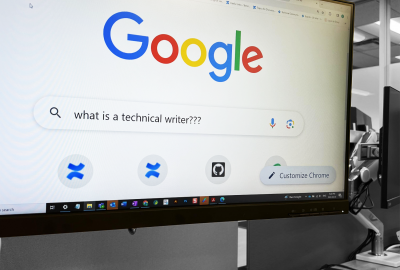
Like Indiana Jones experiencing a Co-op adventure, I’ve been collecting valuable artifacts from school projects to work assignments. Tumbling through papers and projects, taking those strategic steps from classes into Co-op, and pushing my way through dense webs of average papers, I discover the treasure – work worthy to be in my portfolio.
With all the adventures I am undergoing, there should be some organization of my collections. But how? A good rule of thumb when putting together a portfolio is to make a sandwich – put the strongest items of the portfolio first, have the weakest in the middle, and then finish with the second best samples.
Here are some possible layouts: considering I have several oversized published articles, I find it very hard to include them in a regular-sized binder. To compensate the size, I ended up folding my writing samples in half, glued them to loose-leaf paper, and fastened it with a binder. Typically, display work samples in plastic sleeves for protection and presentation.
Larger work pieces need to be in a separate portfolio created to compliment their size. Portfolios bigger than letter size are acceptable; however, if I want the employer to have minimal struggle handling my portfolio, then I will make it letter size. If it were necessary for me to create an oversized portfolio, I wouldn’t worry about the size because it shows diversity in my work. On the other hand, I printed my visual designs to letter size in order to have them in plastic sheets. Although the employers won’t experience the full effect of the design, it makes it easy for them to carry my portfolio and take quick glances at it.
These are the basic portfolio necessities:
-
3-ring binder
-
Plastic sleeves
-
Table of contents with corresponding tabs
-
10 – 20 pages are sufficient for a strong portfolio.
There are several methods of putting together a portfolio, but here are two suggestions that appear to be the most commonly used:
-
By subject: organize samples by topics including academic knowledge or work experience, such as independent study, lab experience, or internship.
-
By skill or technique: order the items according to skills and knowledge. For example, separate portfolios by skill – my writing and design samples are in different folders. I only display the portfolio relevant to the job description. Moreover, if the position requires teamwork, public speaking, computer and communication skills, organize the portfolio depending on those skill areas.
When I thought I was finished with my portfolio, I failed to notice that there is a lot more to do than simply putting it together. When employers look at my work, they will not understand the context behind my samples, which means that I have to write a small synopsis of each portfolio piece. This will include the rational behind its creation, the tools used, and how the skills used applies to the potential position. It is important to have explanations of your work in a portfolio because the employers are unaware of your roles in the previous jobs.
If I really want to impress an employer, I can’t be a mess like Indiana Jones; instead, I’ll bring extra copies of work to the interview. Sometimes they like to handle your artifacts displayed in the portfolio; and since some of samples are originals, it would be best to hand out copies.
The organization of a portfolio is clear to me now. When I began my interview adventure, I didn’t understand what a portfolio should look like or what is included. But as I have been researching and collecting ideas and advice from people hidden deep within cathedrals and mountain tops, my portfolio is becoming much stronger and ready for the work world to see. The same will happen to you once you begin working on the details of a portfolio!














